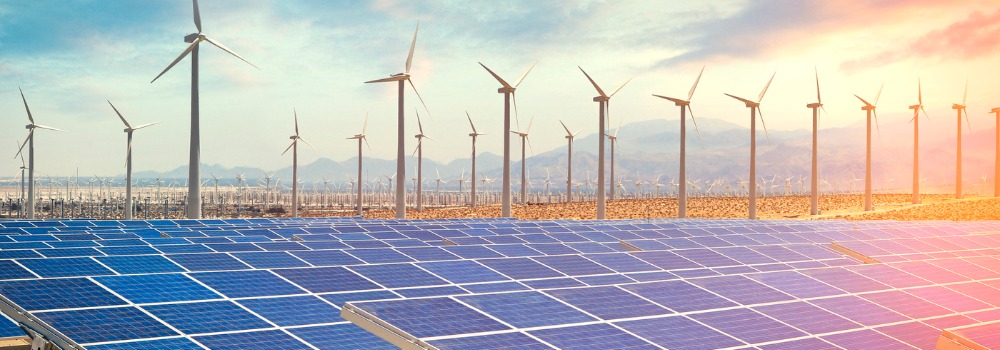As we move toward greener and cleaner energy sources, the question isn’t whether renewable resources will be adopted. The question now is which green energy source is the most efficient.
We’ve gone from relying on fossil fuels to having a selection of viable renewable energy sources in a very short period of time, and the industry is still innovating. Right now, solar energy and wind energy are the most widely utilized types of renewable power.
You may be wondering which one is more efficient: solar energy or wind energy. Because these are naturally derived energy sources, the most efficient option largely depends on the environment where you live. In some locations, solar energy is going to be much easier to produce, but in other places wind energy is more readily available.
Let’s take a look at some of the factors that influence the efficiency of wind and solar energy.
Wind Energy: More Efficient, Less Abundant
At this time, wind turbines are considered more efficient than solar panels.
So, how efficient are solar panels?
The most efficient solar panels can capture and convert about 23% of sunlight into energy. Not bad, but wind turbines turn roughly 50% of captured wind into energy.
Looking at those basic measurements, wind energy appears to be more than twice as efficient as solar energy. However, that’s only the case in areas where the wind is abundant and constant.
The benefit of utilizing wind energy
Wind power meets all the conditions for green energy because it is a clean, abundant, and renewable source of energy. Wind, like the sun, is a continual source of energy.
Careful consideration goes into wind turbine placement. The general recommendation is to place wind turbines in areas with average wind speeds of 12 MPH. Even in windy areas, one of the downsides of wind energy is inconsistency. The fluctuation in the wind makes it hard to estimate how much energy will be produced for a given period.
When it’s not raining you can count on the sun to supply a certain amount of energy over the course of a specific number of hours, even if it’s cloudy. Unlike the wind, the sunlight won’t completely drop off for hours on end. That is until the sunsets.
Wind may not be as abundant and consistent as sunlight, but turbines can catch a breeze at any time of day. This nighttime energy generation gives wind turbines a serious advantage over solar panels and helps offset issues of inconsistency.
If you’re interested in using clean energy, Verde Energy is the company for you! We’ve helped thousands of consumers in making the switch to renewable energy. Get in touch with us today to learn more about renewable energy!
The Environmental Cost of Creating Turbines and Panels
When you’re gauging the efficiency of an energy source, one of the biggest factors is what’s required to capture the energy. If the amount of energy that’s generated is close to the same amount needed to source the energy, then it isn’t very efficient.
Building solar panels and wind turbines requires a fair amount of energy that comes from fossil fuels. Some have pointed out that this makes renewables less green than initially thought. The Science Explorer estimated that wind turbines have a carbon footprint of 7-56 grams of CO2 for every kilowatt-hour generated and solar panels have a carbon footprint of 9-180 grams of CO2 for each kilowatt-hour.
Is wind energy still considered environmentally friendly?
Wind energy is a renewable resource. In general, wind energy has minimal environmental consequences versus other energy sources. Wind turbines do not emit pollutants into the air or water.
While it does impact the overall carbon emissions associated with energy production, it shouldn’t impact efficiency.
How long does it take a wind turbine to pay for itself?
It’s determined by the geographical location of the wind turbine and the turbine’s ability to capture energy, which is dependent on wind flow.
Innovation Could Change Which Energy Source is More Efficient in the Future
As we’ve seen in the last few decades, the efficiency of renewables has improved dramatically. Solar panels, in particular, have become much better at capturing energy. Given that engineers are continuing to make improvements that increase efficiency, there’s a good possibility in the near future solar panels will outperform wind turbines.
The other thing that could give solar energy the edge is the ability to install individual systems on homes. The vast majority of properties aren’t suitable for a residential wind turbine or it’s not allowed in the zoning, whereas many homes can accommodate a solar panel system.
The Pew Research Center notes that around 6% of homes have solar panel systems, but more homeowners are now seriously considering it. In 2016 40% of homeowners were considering solar power. Just three years later in 2019, that number was up to 46% of homeowners. There’s also been a 44% increase in the amount of solar power that was installed in 2019 and 2020. Those numbers suggest solar energy will continue to grow. As long as there is demand there will be innovation that improves the technology.
What is the relationship between solar and wind energy?
Solar energy includes wind energy. The sun heats the earth’s atmosphere and the earth’s spinning around the sun contributes to the output of wind. The air above the land heats up faster than the air above the sea during the day. When hot air moves up it is replaced by colder, heavier air, helping to produce wind.
Solar Farms
Another change that’s leveling the playing field between solar power and wind energy is the growing number of solar farms. These are huge arrays off the beaten path that are connected to the grid to supply nearby homes with clean energy. Typically, solar farms lower the cost of using solar energy at home and can be more efficient than single residential solar systems.
Solar Panel Types
Solar panels come in a variety of forms: Monocrystalline solar panels, polycrystalline solar panels, and multi-junction solar panels are the most popular types of solar panels.
What are the most energy-efficient solar panels?
Monocrystalline is the most efficient of all the other two types of cells. Thermal cells catch the sun’s heat directly and are especially effective in hotter climes.
So, which is preferable: solar or wind energy?
When it comes to pure energy produced, wind power presently outperforms solar. Solar energy is a lot more realistic choice for homeowners. However, the most important factor is location. There is no such thing as a one-size-fits-all answer in the realm of energy. Solar cells are more feasible for suburban or metropolitan areas since they may be mounted on the rooftops of residential and business buildings.
Whether you prefer solar energy or wind energy, Verde Energy strives to supply reliable electricity plans. No matter how renewable energy evolves you can count on a fixed rate that makes energy costs more predictable.
All you need is a zip code to see what Verde Energy electricity plans are available in your area.



